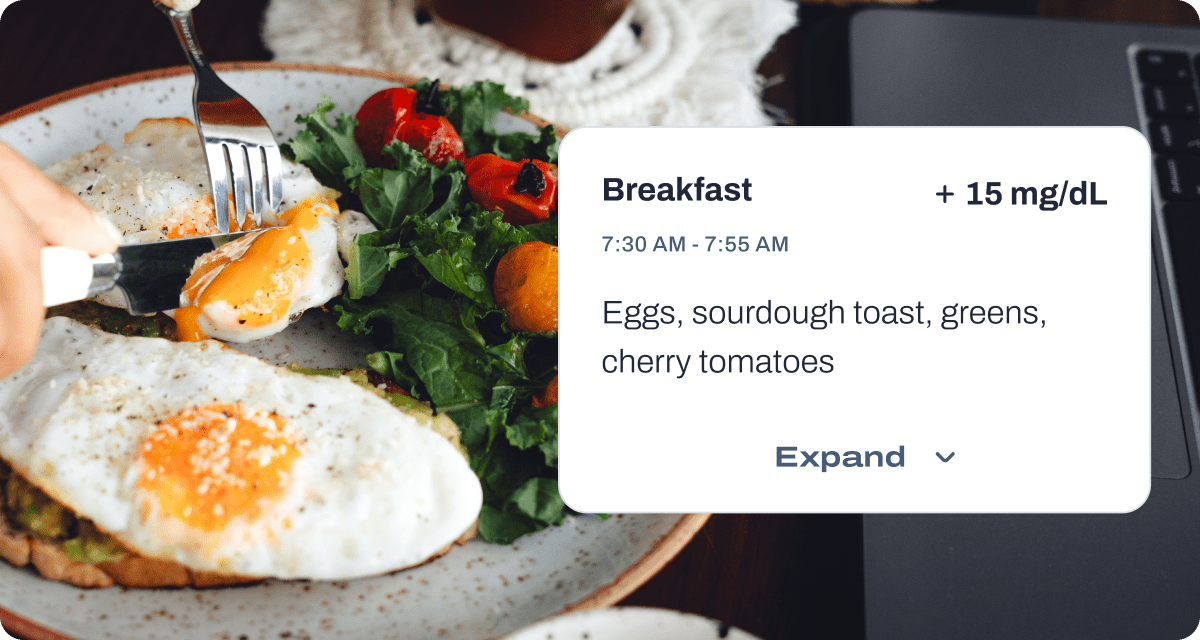Key Takeaways
- Seasonal Affective Disorder (SAD) disrupts mood, metabolism, and hunger cues, especially in darker months.
- Serotonin, melatonin, and circadian rhythm changes drive cravings for carbohydrates and comfort foods.
- Balanced meals, movement, light exposure, and Signos’ glucose insights can help you manage SAD-related cravings effectively.
that {{mid-cta}}
When the days get shorter and the sunlight seems to vanish, many notice more than a shift in mood; they feel it in their metabolism, too. Many feel that weight gain is easier or even inevitable in the colder months. But why is that? Seasonal Affective Disorder (SAD) affects more than 10% of the population in northern climates, and for countless others, the “winter blues” bring subtle changes in sleep, energy, and appetite.1
If you’ve ever found yourself reaching for extra carbs or craving sweets as soon as the temperature drops, you’re not imagining it. Shorter daylight hours affect your brain chemistry and internal clock, increasing both hunger and the appeal of quick comfort foods.
Let’s unpack the science behind SAD, and what you can do to feel better this winter.
What Is Seasonal Affective Disorder (SAD)?

Seasonal Affective Disorder (SAD) is a type of depression that follows a seasonal pattern in the fall and winter months when daylight hours shorten. According to the National Institute of Mental Health, symptoms typically include low mood, fatigue, oversleeping, difficulty concentrating, and a noticeable increase in appetite, especially for carbohydrates and sweets.2
Although SAD is often dismissed as the “winter blues,” it’s more than just feeling sluggish on cold days. It’s a real mental health condition linked to how your brain and body respond to less sunlight. Fewer daylight hours disrupt your internal clock, altering brain chemicals like serotonin and melatonin and creating a ripple effect that influences both your emotional state and your eating habits.
Light exposure plays a critical role in SAD symptoms. When sunlight decreases, your body produces more melatonin, the hormone that makes you feel sleepy, while serotonin, a neurotransmitter that boosts mood and supports appetite control, tends to drop. Together, these changes can leave you tired, hungry, and drawn toward calorie-dense comfort foods.
The Biochemistry of SAD and Cravings

There’s real biochemistry behind why you reach for warm bread, pasta, or sweets when the days get darker. SAD doesn’t just shift your mood; it alters your neurotransmitters, hormones, and metabolic rhythms, creating a perfect storm that increases cravings for carbohydrates.
1. Serotonin Depletion Fuels Carb Cravings
Serotonin is the brain chemical that helps regulate mood, appetite, and other functions. In winter, reduced sunlight exposure lowers your serotonin production. Your body, in turn, looks for a quick fix for those feel-good feelings, often through carbohydrate-rich foods, which temporarily raise serotonin levels.
2. Melatonin and Sleep Timing Shift
And with less sunlight, your pineal gland produces more melatonin, the hormone that promotes sleep. This can cause feelings of low energy, sluggishness, and even oversleeping, which may further disrupt your internal clock. When melatonin levels rise during the day, your hunger and fullness cues can fall out of sync, leading to eating at unusual times or grazing for energy.
3. Cortisol and Stress in Winter
The darker months can also elevate cortisol, the body’s primary stress hormone. Higher cortisol levels encourage fat storage and amplify hunger, particularly for sweet or fatty comfort foods. Combine that with lower serotonin, and your body is wired to seek out “fast fuel” to cope with stress and low mood.
4. Circadian Rhythm and Vitamin D
Less sunlight also means lower vitamin D production, and vitamin D is a nutrient that interacts closely with serotonin and circadian rhythm regulation. In the winter months, many folks in the northern hemisphere are at risk of developing low vitamin D levels, which in turn can affect mood and may lead to a change in emotional or comfort eating behaviors.
Why SAD Intensifies Food Cravings
The combination of low serotonin and low sunlight makes the brain more reactive to stress and sadness in the winter. Since carbohydrate-rich comfort foods give a quick serotonin boost, that explains why a plate of mashed potatoes or a cookie feels emotionally soothing in the moment. Over time, though, this pattern can lead to overeating and unwanted weight gain, a familiar struggle for people with seasonal affective disorder.
From an evolutionary standpoint, our bodies may be wired to crave energy-dense foods in winter. Historically, periods of darkness and cold meant conserving energy and storing fat for survival. Modern-day life, however, doesn’t require those same adaptations, yet our biological responses haven’t caught up. The result: we still crave comfort foods when sunlight is scarce, even though our daily energy needs stay about the same.
The Metabolic Playbook: Managing SAD and Food Cravings

The good news is that while Seasonal Affective Disorder can disrupt your mood, sleep, and metabolism, building awareness of these internal changes can help you armor against seasonal cravings and metabolic shifts this year.
Here’s what you can focus on to prevent unwanted weight gain from SAD this season:
- Prioritize Protein- and Fiber-Forward Meals: When your body craves quick carbs in the winter, what it really needs is steady energy. Meals that include both protein and fiber help stabilize blood sugar levels, preventing the highs and crashes that worsen fatigue and cravings. Plus, research shows that balanced meals support serotonin regulation, helping to ease symptoms of depression and potentially reducing the tendency to overeat.3
- Move Your Body: Exercise is one of the most effective ways to boost serotonin naturally, support vitamin D levels, and reset your internal clock, all of which help manage SAD. Regular movement helps your brain release feel-good neurotransmitters that balance stress hormones and may curb emotional eating in the winter.4
- Optimize Your Sleep Hygiene: Shorter days and higher melatonin production can make you feel groggy or lead to oversleeping. Reestablish your natural rhythm with a consistent bedtime and wake-up time, even on weekends. Get bright light exposure within the first hour after waking to cue your internal clock that it is time to wake up. Avoid screens for at least 30 minutes before bed to improve sleep quality and prevent disrupted nights’ sleep.5
- Try Light Therapy and Vitamin D Support: Pairing light therapy with adequate vitamin D intake, whether from fortified foods, safe sunlight, or a supplement recommended by your healthcare provider, may provide physiological support during winter months. Research shows that those who suffer from SAD tend to have low vitamin D levels as well, though this connection needs more research.6
How Signos Supports You Through SAD Season

Signos gives you a real-time view of how shorter days, stress, and comfort-food cravings affect your glucose. With continuous monitoring and personalized insights, you can spot patterns, such as afternoon dips, post-meal spikes, or elevated overnight glucose, that often occur during SAD season. The app helps you connect these shifts to behaviors such as light exposure, sleep timing, and movement.
You can run simple, guided experiments to see what works best for you:
- Morning light exposure: Step outside for 10–15 minutes after waking and track whether your glucose dips are smaller or your energy feels steadier.
- Protein-first breakfast: Swap a carb-heavy morning meal for protein and fiber to see if post-meal spikes are reduced.
- Timed movement: Try short walks or stretching sessions during afternoon dips and watch how your glucose responds.
- Evening wind-down: Track whether limiting late-night snacking or reducing screen time helps stabilize overnight glucose.
By experimenting with small, data-driven adjustments, Signos helps you support steady energy, balanced appetite, and improved mood throughout the season.
The Bottom Line
Seasonal Affective Disorder doesn’t just make you feel sad…it also affects your metabolism, appetite, and energy levels. By understanding how light, serotonin, and circadian rhythms shape your cravings, you can take practical steps to support both mental and metabolic health.
Learn More With Signos’ Expert Advice
With tools like Signos, you can see how these changes play out by tracking your blood sugar in real time, making it easier to connect the dots on how those mood-driven cravings affect you and start creating habits that support your health in the cold months, too.
If you’re curious about how your glucose patterns shift through the seasons or want to better understand your body’s metabolic health, Signos can help. Explore more expert-backed insights on nutrition and metabolism on the Signos blog, and discover how small daily habits can make a big difference in how you feel year-round.
Topics discussed in this article:
References
- Depression. National Institute of Mental Health. Accessed October 23, 2025.
- Magnusson A, Boivin D. Seasonal affective disorder: An overview. Chronobiol Int. 2003;20(2):189-207. doi:10.1081/CBI-120019310
- Kris-Etherton PM, Petersen KS, Hibbeln JR, Hurley D, Kolick V, Peoples S, Rodriguez N, Woodward-Lopez G. Nutrition and behavioral health disorders: depression and anxiety. Nutr Rev. 2021 Feb 11;79(3):247-260.
- Shen B, Ma C, Wu G, Liu H, Chen L, Yang G. Effects of exercise on circadian rhythms in humans. Front Pharmacol. 2023 Oct 11;14:1282357.
- Yuan RK, Pardilla-Delgado E, Zitting KM, Duffy JF. Tips for circadian sleep health while working from home. Southwest J Pulm Crit Care. 2020;20(4):126-127. PMID: 32341887; PMCID: PMC7185226.
- Seasonal Affective Disorder. NCCIH. Accessed October 23, 2025.



.webp)
.svg)










.svg)
.svg)
.svg)
.svg)
.svg)
.svg)
.svg)
